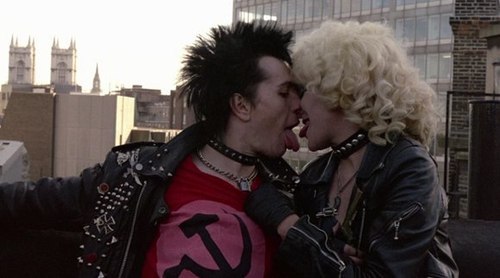This year has seen a revival of the punk era. Exhibitions at the British Library, ICA and The Photographer’s Gallery in London have charted the period while the Resolution Festival in January at The 100 Club had contemporary punk artists take to the stage. 40 years prior, The Sex Pistols performed at the 100 Club and 1976 became the date-of-birth for the punk movement. Directed by Alex Cox, Sid and Nancy takes us back to the movement, kicking and screaming, with the tragic, drug-addled story of Sid Vicious and his girlfriend Nancy Spungen.
40 years prior, The Sex Pistols performed at the 100 Club and 1976 became the date-of-birth for the punk movement. Directed by Alex Cox, Sid and Nancy takes us back to the movement, kicking and screaming, with the tragic, drug-addled story of Sid Vicious and his girlfriend Nancy Spungen.
Bookended by that fateful day in the Chelsea Hotel in New York City, we’re then transported back in time to Sid (Gary Oldman) and Johnny Rotten (Andrew Schofield) scoffing, and prowling an upper class London street. A mutual friend introduces them to Nancy (Chloe Webb), and as the Pistols grow in popularity, Sid and Nancy fall in love – and fall further into heroin addiction. The rebelliousness of the band and the fame-seeking manager Malcolm McLaren (David Hayman) only seemed to support Sid and Nancy’s self-destructiveness, ultimately leading to the breakup of the band during an American tour. While Nancy seems to be the driving force behind Sid’s addiction, he is blissfully ignorant to the advice of others and their demise becomes less unexpected and more inevitable.
Released ten years after the Sex Pistols punk beginning, Sid and Nancy earned little at the box-office in 1986, despite garnering critical support (leading to a cult following). Gary Oldman’s performance was heralded as another outstanding success while Chloe Webb’s whiney and unhinged portrayal has been celebrated as brutally “realistic”. Both characters drive the film forward, balancing the biopic-nature of the tale with an intimate human touch. The spittle-fuelled and torn-clothes definition of the era is captured in all its fierceness and, outside of Sid and Nancy, Cox looks back at the time with rose-tinted spectacles.
A stylish, bold movie, Sid and Nancy misses the opportunity to put in context the truth behind Sid Vicious. It’s like someone has read a book on the punk movement and, using the photographs, recreated it. It reminds me of Lock, Stock and Two Smoking Barrels; fun to watch, but I doubt a group of London low-level criminals speak with such impeccable language, with such smart witty retorts. Sid and Nancy, in the same manner, depicts the punk London we hope existed, with a dark, moral edge to reflect upon.
The pairing of Sid and Nancy plays out like Bonnie and Clyde. Their anti-establishment attitude neatly pre-figures the American runaways portrayed in both Natural Born Killers and True Romance. As crazy as they may be, Mallory Knox and Alabama Whitman both owe a debt to Chloe Webb’s depiction of Nancy. Gary Oldman, spaced and disconnected, still manages to give Sid a boyish charm to keep us on side. The chaotic context sits in direct opposition to the in-film-referenced, hippy classic, Easy Rider. Both share two central figures coasting through life, trying to find a place, only to meet a grisly end by the final credits. Whereas Easy Rider has a plan and direction, Sid and Nancy don’t even know where they are half the time.
Sid and Nancy is a vivid representation of these troubled people. It’s loud, in-yer-face and aggressive, but beneath the bravado is a sad story of a passionate woman and a man who had yet to find his place in the world, despite the world already knowing him.
Originally written for Culturefly in September 2016

